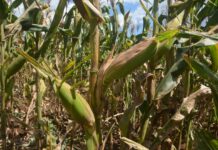By : Chipo Tachiona
Cattle farmers and indeed the country has suffered huge losses to the beef herd due to theileriosis (commonly referred to as January disease).This has brought about the loss of economic security as cattle are a vital wealth source.To combat these losses there has to be strict adherence to dipping.
The term cattle dipping means the application of acaricide to cattle for the purpose of destroying parasites which infest their skin, especially ticks.
METHODS OF DIPPING CATTLE
A Plunge dip is a structure that enables total immersion of livestock in water charged with an acaricide. They are either concrete based, fixed, or transportable. Plunge dips, when built and utilized properly, ensure that the entire animal is soaked. Maintaining correct dipping and replenishing records is crucial because insufficient dipping results in ineffective tick management and tick resistance to acaricides. Of paramount importance is the observation of the manufacturer’s instructions on charge and re-charge as this has been the archilles heel of this method. In most cases farmers are continuing to use under strength/compromised dipping mixture due to reliance on the ‘smell test’ i.e. if you can smell the chemicals then all is well when infact they would be running weak solutions that encourage tick resistance build up over time. All animals must be dipped every dip day, apart from very young calves and highly pregnant cows (pregnant, young, sick, or old animals may not be dipped at all but can be sprayed or treated with alternate treatments). Fixed dips must be long, wide, and deep enough to totally submerge the animal as it plunges and force it to swim a distance before striking the bottom.
Since there is less risk of harm, the cattle spray race is a gentler way of dipping and has grown to be an effective and efficient alternative to plunge dips. Cattle walk through a tunnel and are sprayed with acaracide solutions targeted at all parts of the animal. Contrary to the plunging dip. A thorough soaking of the animal’s body has become possible with the advent of well-engineered/designed systems. To ensure that all ticks attached to the animal’s body are killed by the chemical, the level of wetness shouldn’t differ from that of cattle going through the plunge dip. To guarantee appropriate cover and successful tick management, however, proper maintenance and practices must be followed. In order to achieve an even cover, nozzles must be carefully set, regularly removed, and cleaned. The spray race needs to be at the proper pressure. Without creating a mist, the dip wash must penetrate the animal’s coat. Dip wash will not adequately penetrate the coat, the animal’s ears, or the area under its tail if the pressure is too low.
Topical treatments (Pour-ons) are acaracides that are concentrated and applied topically to an animal’s skin in tiny dosages. They contain a spreading component, typically oil-based, that enables the dip to cover the animal’s skin. Pour-ons are more expensive than plunge or spray dips, but they are more effective against flies and midges and can be used in fly control programs. Pour-ons can be used on a few animals or as a temporary solution, but they shouldn’t be relied on for total tick control. Pour-ons must be applied to dry animals; if it rains on them right after treatment, the pour-ons may not work as intended.
For a few animals that do not warrant the expenditure of a spray race or plunge dip, such as on small-scale commercial dairy farms, hand spraying is an effective tick control strategy. It is necessary to use a reliable knapsack sprayer and regulate the pressure so that the animal receives a full wetting without the spray condensing into a mist. For cattle, 7 to 9 litres of dip wash are needed per head; for sheep and goats, this amount is lower. To guarantee that the skin is saturated, spraying should be done against the direction of the hair growth. Sheep and goats can be treated for ticks by hand-spraying.
Applying tick greases or oils topically to areas of the animal where ticks concentrate, such as the ears or beneath the tail, is known as hand dressing. It can be used as a spot treatment in between dip days or in addition to any other way of tick management, but it shouldn’t be used as a sole means of tick prevention. Tick greases and oils typically have a pretty long residual time and adhere better to hairless skin.
Injectable Parasiticides, these have some effectiveness against ticks and are used to control internal parasites. They are typically only effective against single-host ticks and are too expensive to be utilized for complete tick control. (Blue tick)
WHEN SHOULD CATTLE BE DIPPED
Farmers should get knowledge of when and what to vaccinate their cattle against because vaccination and dipping are not done in one season but rather at different periods throughout the year when certain diseases are prevalent. Cattle are dipped once every two weeks while it’s dry out. With the arrival of summer, this plan must shift so that January disease hotspots must dip their cattle three times in 14 days in accordance with the 5:5:4 dipping schedule.
Note: To prevent using bogus chemicals that could end up fostering tick resistance or possibly hurting the cattle, dip chemicals should only be purchased from trustworthy suppliers and not from the streets.
More than 65 percent of cattle deaths in Zimbabwe is caused by tick-borne diseases, with 500 000 cattle valued at US$150 million having died of January disease from 2018 to 2022.
Early detection of tick manifestations help to save animals,but prevention is better than cure, which means farmers must dip their animals regularly to prevent tick-borne diseases. This is crucial as the country journeys towards an upper middle-class economy as envisioned in Vision 2030.








